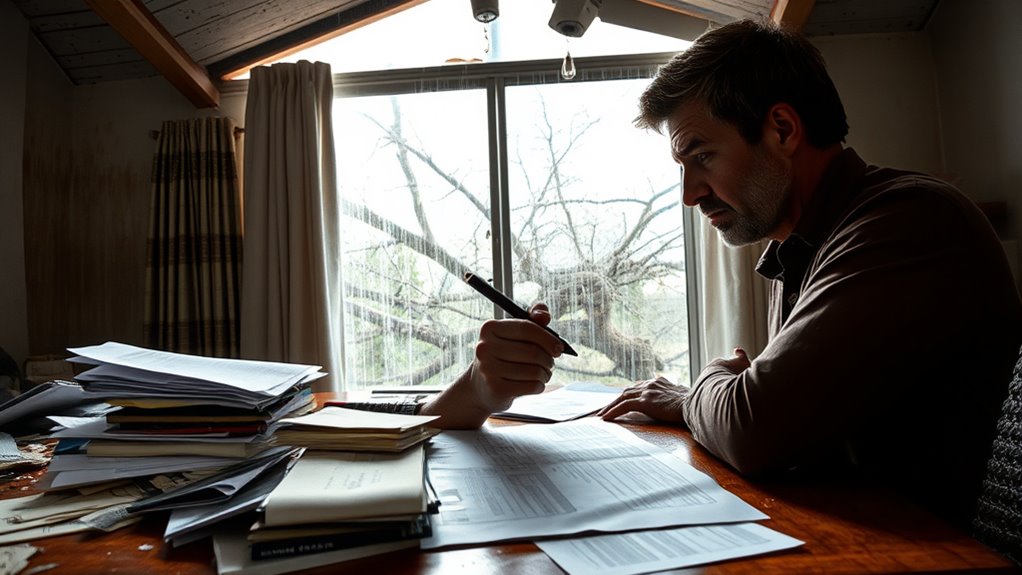After storm damage, act quickly by contacting your insurance company and providing photos or videos of the damage. Review your policy to understand coverage, including limits and deductibles. Keep detailed records of all conversations and documents related to the claim. Be present during inspections to ensure all affected areas are evaluated properly. If disagreements arise, consider seeking additional opinions or clarification. Continuing will guide you through each step to help you get your property restored efficiently.
Key Takeaways
- Contact your insurance company promptly and document storm damage with photos and videos.
- Review your policy to understand covered damages, exclusions, deductibles, and limits.
- Keep detailed records of all communications, reports, and estimates related to your claim.
- Be present during damage inspections and challenge discrepancies to ensure comprehensive assessment.
- Carefully review and negotiate settlement offers to ensure they reflect the true extent of damage.

Have you just experienced a storm that caused damage to your property? If so, you’re likely feeling overwhelmed and unsure about what steps to take next. The first thing you should do is contact your insurance company promptly to initiate the claims process. When you reach out, be prepared to discuss the extent of the damage and provide any initial documentation you have, such as photos or videos. This helps set the stage for an efficient claims adjustment process. During this step, the insurance adjuster will evaluate the damage to determine how much the policy coverage will pay toward repairs. It’s essential to understand that claims adjustment isn’t just a formality; it’s a detailed process where an expert assesses your property’s damage to guarantee your claim is accurately valued. Knowing your policy coverage is imperative here. Review your insurance policy carefully before filing the claim so you understand what types of damage are covered and any exclusions or limitations. For example, some policies may cover wind and hail damage but exclude flooding unless you have specific flood insurance. Being familiar with your coverage helps prevent surprises later on.
Once you’ve reported the claim, the insurance company will assign an adjuster to your case. It’s your job to facilitate this process by providing all necessary documentation and answering questions honestly. Keep track of all communications with your insurer, including emails, phone calls, and any in-person meetings. Take detailed notes of what the adjuster says and request copies of all reports and estimates related to your claim. This documentation becomes essential if any disputes arise or if you need to escalate your claim. During the claims adjustment, the adjuster will inspect the damage and estimate repair costs based on current market prices. Be present during the inspection if possible, and point out all affected areas to ensure nothing is overlooked. If you disagree with the adjuster’s assessment, don’t hesitate to seek a second opinion or request a reconsideration. You’re entitled to review the adjuster’s findings and challenge any discrepancies. Additionally, understanding third-party cookies can help you better manage your online privacy while researching claims and coverage options.
Throughout the process, maintain a clear understanding of your policy coverage. Know the limits, deductibles, and specific items covered to avoid misunderstandings. If your claim is approved, the insurance company will issue a settlement check, but it’s wise to review the settlement offer carefully to confirm it aligns with the damage assessment. If it doesn’t, you have the right to negotiate or provide additional evidence to support your claim. Handling insurance claims after storm damage can be complex, but staying organized, informed, and proactive will help you navigate the process smoothly and get the support you need to restore your property.
Frequently Asked Questions
How Long Does the Insurance Claim Process Typically Take?
The insurance claim process usually takes anywhere from a few weeks to a couple of months, depending on the claim settlement timeline and insurance processing duration. You might experience delays if the damage is extensive or if paperwork isn’t complete. To speed things up, make certain you provide all necessary documentation promptly and stay in regular contact with your insurer. Patience and proactive communication can help you navigate the process more smoothly.
What Documents Are Required to File a Claim?
Did you know that 80% of claim delays happen due to incomplete documentation? To file your claim, gather essential insurance documentation like photos of storm damage, a detailed damage report, proof of ownership, and your insurance policy number. When you’re ready for claim submission, having these documents organized speeds up the process and helps guarantee you receive fair compensation quickly. Don’t forget to keep copies for your records!
Can I Choose My Own Repair Contractor?
Yes, you can choose your own repair contractor, but the selection process often requires verifying their licensing and credentials. Insurance companies typically prefer contractors who are properly licensed and experienced, ensuring quality work. Make sure to provide your insurer with the contractor’s information for approval. This helps streamline the claim process and guarantees your repairs meet standards, giving you peace of mind during the restoration after storm damage.
Will My Premium Increase After Filing a Storm Damage Claim?
Your insurance premiums might go up after filing a storm damage claim, but it’s not guaranteed. Insurance premiums can increase depending on the claim’s size, your policy history, and the insurer’s policies. Keep in mind, if your claim gets denied, it won’t affect your premiums. To avoid surprises, review your policy details and speak with your insurer about how claims could impact your premiums before filing.
What if My Claim Is Denied by the Insurance Company?
If your claim is denied, don’t give up. You can start the appeal process by reviewing the claim denial reasons carefully and gathering additional evidence or documentation to support your case. Contact your insurance company to discuss the denial and ask for clarification if needed. By following the appeal process and addressing the claim denial reasons directly, you improve your chances of overturning the decision and receiving the compensation you deserve.
Conclusion
After a storm, timely action is key to a smooth insurance claim process. Remember, filing within the specified window increases your chances of coverage. Did you know that over 60% of storm damage claims are denied due to delayed reporting? By acting quickly and documenting everything, you improve your chances of getting the help you need. Stay proactive, stay informed, and don’t hesitate to reach out to your insurer promptly. Your swift response can make all the difference.









